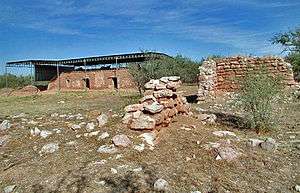Mission San Cayetano de Calabazas
Coordinates: 31°34′05″N 111°03′02″W / 31.5681465°N 111.0506458°W
|
Ruins of the mission compound and church at Mission San Cayetano de Calabazas. | |
| Location | near Nogales, Arizona |
|---|---|
| Name as founded | La Misión de San Cayetano de Calabazas |
| English translation | The Mission of Saint Cajetan of the Gourds |
| Patron | Saint Cajetan |
| Founding date | 1756 |
| Founding priest(s) | Father Francisco Xavier Pauer |
| Built | 1756 |
| Native tribe(s) Spanish name(s) | Pima |
| Current use | Historical Monument |
| Designated | June 3, 1971[1] |
| Reference no. | 71000118 |
| Designated | December 14, 1990[2] |
Mission San Cayetano de Calabazas, also known as Calabasas, is a Spanish Mission in the Sonoran Desert, located near present-day near Tumacácori, Arizona.
History
It was founded by Spanish Jesuit missionary Father Francisco Xavier Pauer in 1756. He took at least seventy-eight Pima Indians to the site from their village of Toacuquita. The original San Cayetano mission was at Tumacacori and was founded by Father Eusebio Kino in 1691 on Kino's first major exploration trip into the Pimeria Alta. The mission church, houses and the granary were set ablaze during an Apache attack in 1777. The Mission was abandoned in 1786 due to continuing problems with the indigenous peoples.
- 19th century
Between 1807 and 1830 the settlement area was used as an estancia (farm) for nearby Mission San José de Tumacácori. In 1808, Spanish settlers moved into Calabazas and restored the chapel. In response, the Apaches again attacked, setting fire to the buildings and carrying off sacred vessels and vestments in the process. The property was sold to Governor Manuel Gándara of Sonora in 1808.
In 1837, the Mexican government built Presidio de Calabasas to protect the mission.
The 1854 Gadsden Purchase, of land by the U.S. from México, included this area in the Arizona Territory. Subsequently, the former mission church served a number of purposes, including a customs house, post office, and a ranch house.
In September 1865 the garrison at Tubac, Arizona was transferred to Old Camp Moore at Calabasas and it was named Fort Mason in honor of General Mason, who was commander of the California Volunteers in the Civil War. The 1st Battalion of Native Cavalry, California Volunteers and 7th Regiment California Volunteer Infantry occupied the post until they were relieved by troops of the United States Army in May 1866. Due to persistent malaria, the Regulars abandoned the fort in October 1866 and established Camp Cameron.
Mission Calabazas was completely abandoned to ruin by 1878, with only a roofless shell remaining.
Preservation
Father Norman Whalen recruited preservation volunteers who capped the adobe walls, and placed a concrete foundation in 1960. The Arizona Historical Society took over site management and ownership in October 1974. The Mission became part of Tumacácori National Historical Park in 1990.[3]
It was declared a National Historic Landmark in 1990, and is on the National Register of Historic Places.[2][4]
See also
- Spanish missions in Arizona
- Spanish Missions in the Sonoran Desert
- National Register of Historic Places listings in Santa Cruz County, Arizona
References
- ↑ National Park Service (2007-01-23). "National Register Information System". National Register of Historic Places. National Park Service.
- 1 2 "San Cayetano de Calabazas". National Historic Landmark summary listing. National Park Service. Retrieved 2007-09-27.
- ↑ "San Cayetano de Calabazas / Calabasas—Accompanying rendering from 1853 and 7 photos from 1913, 1934, and 1990." (pdf). National Register of Historic Places Registration. National Park Service. 1990-03-08.
- ↑ Mark R. Barnes (1990-03-08). "San Cayetano de Calabazas / Calabasas" (pdf). National Register of Historic Places Registration. National Park Service.
External links
- "San Cayetano de Calabazas". Tumacácori National Historical Park. Retrieved November 7, 2006.
- Historic American Buildings Survey (HABS) No. AZ-2, "San Cayetano de Calabasas (Mission, Ruins), Santa Cruz River Vicinity, Nogales, Santa Cruz County, AZ", 4 photos, 4 measured drawings, 2 data pages
